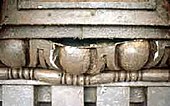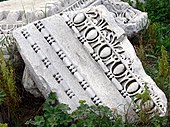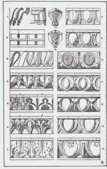Egg-and-dart
Egg-and-dart, also known as egg-and-tongue, egg and anchor, or egg and star,[1] are terms that refer to an ornamental device adorning the fundamental quarter-round, convex ovolo profile of moulding, consisting of alternating details on the face of the ovolo—typically an egg-shaped object alternating with a V-shaped element[1] (e.g., an arrow, anchor, or dart). The device is carved or otherwise fashioned into ovolos composed of wood, stone, plaster, or other materials.
._1_April_1992._-_Jefferson_Memorial%2C_East_Potomac_Park%2C_Washington%2C_District_of_Columbia%2C_DC_HABS_DC%2CWASH%2C453-32.tif.jpg)
Egg-and-dart enrichment of the ovolo molding of the Ionic capital was used by ancient Greek builders so it's found in ancient Greek architecture (e.g., the Erechtheion at the Acropolis of Athens),[2] was used later by the Romans and continues to adorn capitals of modern buildings built in Classical styles (e.g., the Ionic capitals of the Jefferson Memorial in Washington, D.C.). The moulding design element continues in use in neoclassical architecture.[3][4]
Gallery
 The ornament is used to decorate building exteriors and for interior stuccos
The ornament is used to decorate building exteriors and for interior stuccos The egg-and-dart moulding on a building cornice
The egg-and-dart moulding on a building cornice- Archaeological site in Ostia Antica
 Architectural fragment with egg-and-dart moulding in Antalya (Turkey)
Architectural fragment with egg-and-dart moulding in Antalya (Turkey) Egg-and-dart motifs (on right) from Meyer's Ornament
Egg-and-dart motifs (on right) from Meyer's Ornament
References
- Lewis, Philippa; G. Darley (1986). Dictionary of Ornament. New York: Pantheon. p. 116. ISBN 0-394-50931-5.
- Shoe, Lucy T. (1936) Profiles of Greek Mouldings, and Shoe, Lucy T. (1950) "Greek Mouldings of Kos and Rhodes", Hesperia 19(4, Oct-Dec):338-369.
- Regan, Raina (February 21, 2012). "Building Language: Egg-and-dart". Historic Indianapolis. historicindianapolis.com. Retrieved 11 September 2016.
- "Egg-and-dart". Buffalo as an Architectural Museum. buffaloah.com. Retrieved 11 September 2016.
Further reading
- Lewis, Philippa; G. Darley (1986). Dictionary of Ornament. New York: Pantheon. p. 116. ISBN 0-394-50931-5.
External links

